brake VOLKSWAGEN TIGUAN 2017 OwnerВґs Manual
[x] Cancel search | Manufacturer: VOLKSWAGEN, Model Year: 2017, Model line: TIGUAN, Model: VOLKSWAGEN TIGUAN 2017Pages: 341, PDF Size: 9.14 MB
Page 4 of 341
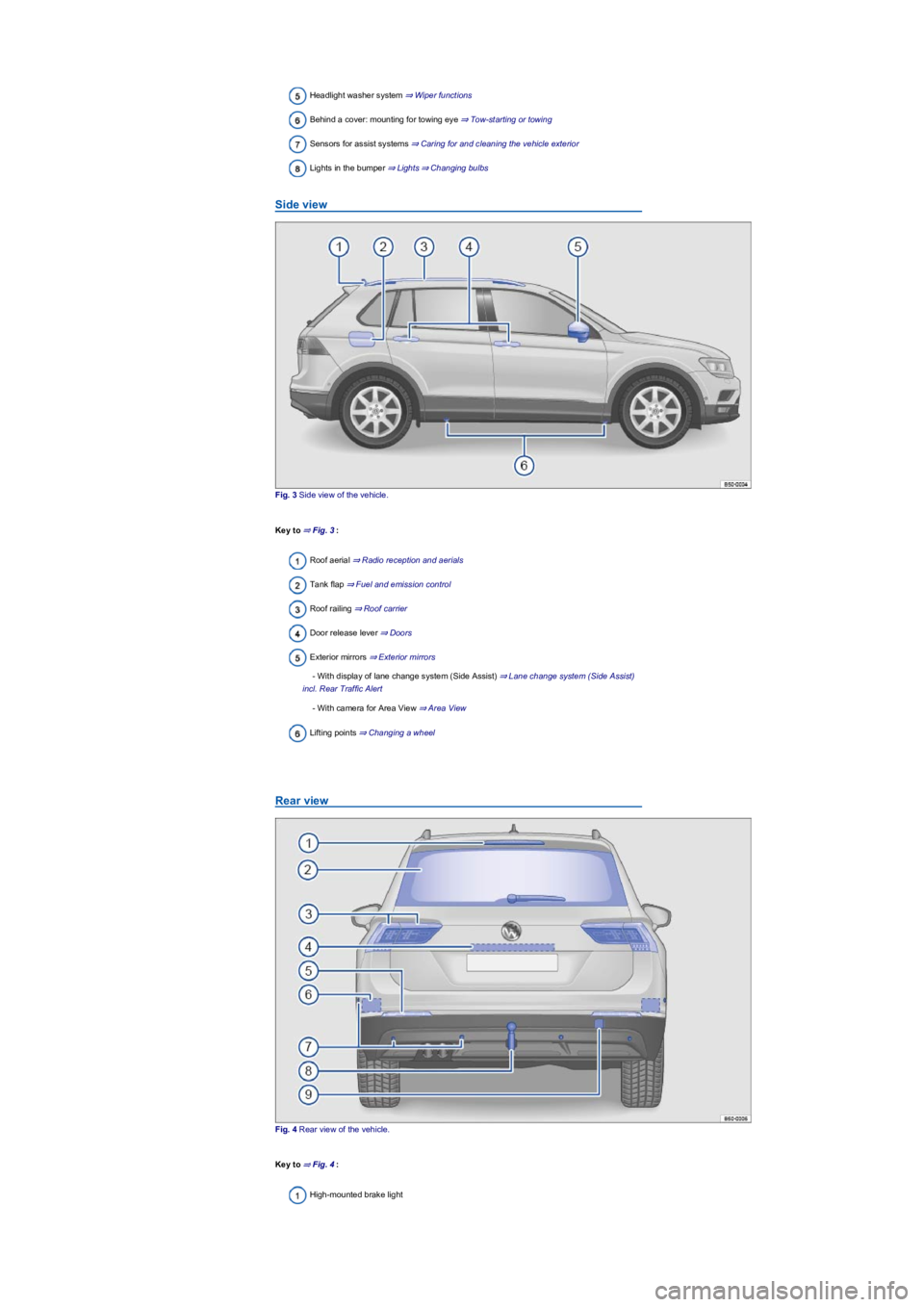
Headlight washer system в‡’В WiperВ functions
Behind a cover: mounting for towing eye в‡’В Tow-startingВ orВ towing
Sensors for assist systems в‡’В CaringВ forВ andВ cleaningВ theВ vehicleВ exterior
Lights in the bumper ⇒ Lights⇒ Changing bulbs
Side view
Fig. 3 Side view of the vehicle.
Key to в‡’В Fig.В 3:
Roof aerial в‡’В RadioВ receptionВ andВ aerials
Tank flap в‡’В FuelВ andВ emissionВ control
Roof railing в‡’В RoofВ carrier
Door release lever в‡’В Doors
Exterior mirrors в‡’В ExteriorВ mirrors
- With display of lane change system (Side Assist) в‡’В LaneВ changeВ systemВ (SideВ Assist)В
incl.В RearВ TrafficВ Alert
- With camera for Area View в‡’В AreaВ View
Lifting points в‡’В ChangingВ aВ wheel
Rear view
Fig. 4 Rear view of the vehicle.
Key to в‡’В Fig.В 4:
High-mounted brake light
Page 9 of 341
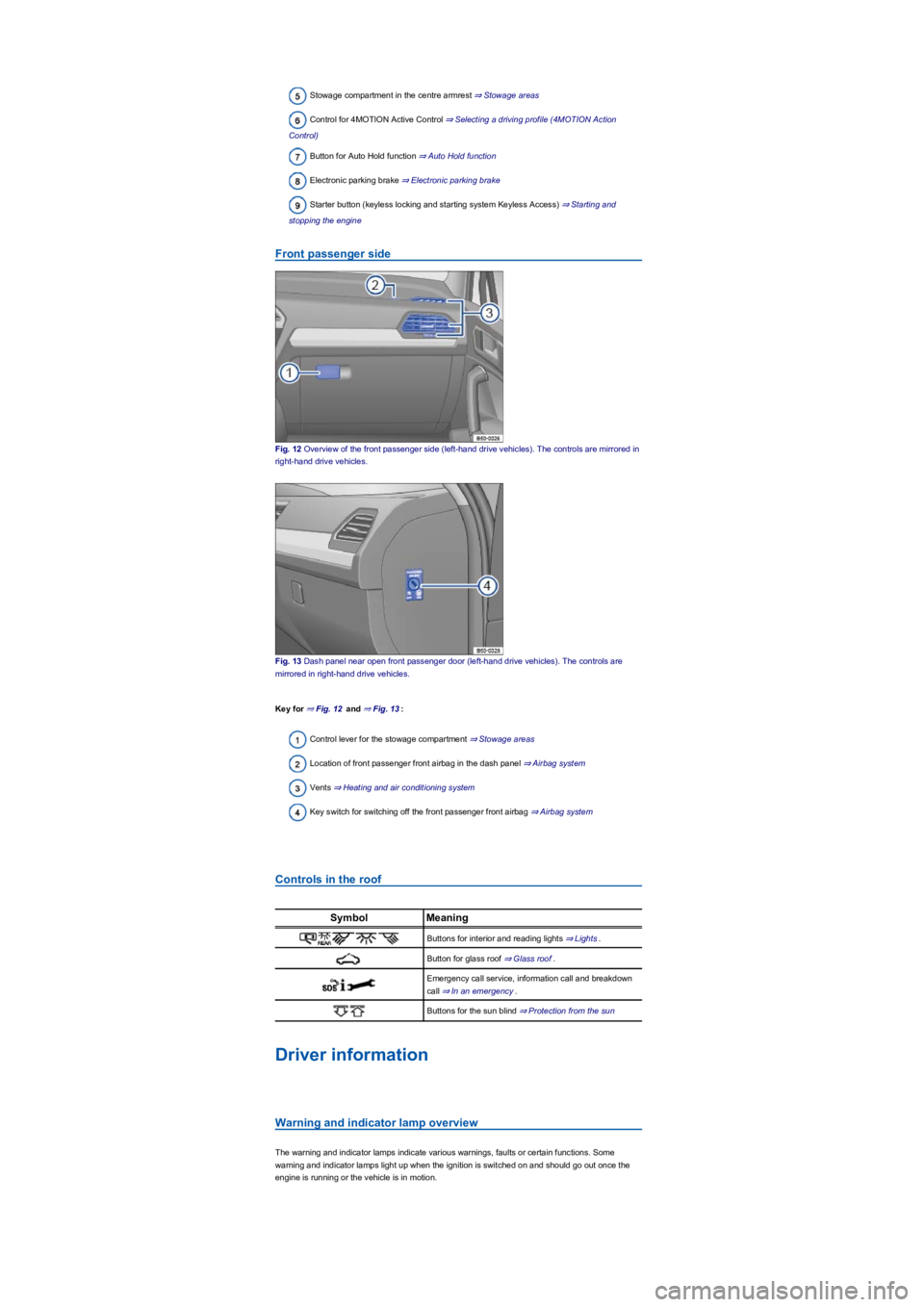
Stowage compartment in the centre armrest в‡’В StowageВ areas
Control for 4MOTION Active Control в‡’В SelectingВ aВ drivingВ profileВ (4MOTIONВ ActionВ
Control)
Button for Auto Hold function в‡’В AutoВ HoldВ function
Electronic parking brake в‡’В ElectronicВ parkingВ brake
Starter button (keyless locking and starting system Keyless Access) в‡’В StartingВ andВ
stoppingВ theВ engine
Front passenger side
Fig. 12 Overview of the front passenger side (left-hand drive vehicles). The controls are mirrored in
right-hand drive vehicles.
Fig. 13 Dash panel near open front passenger door (left-hand drive vehicles). The controls are
mirrored in right-hand drive vehicles.
Key for в‡’В Fig.В 12 and в‡’В Fig.В 13:
Control lever for the stowage compartment в‡’В StowageВ areas
Location of front passenger front airbag in the dash panel в‡’В AirbagВ system
Vents в‡’В HeatingВ andВ airВ conditioningВ system
Key switch for switching off the front passenger front airbag в‡’В AirbagВ system
Controls in the roof
SymbolMeaning
Buttons for interior and reading lights в‡’В Lights.
Button for glass roof в‡’В GlassВ roof.
Emergency call service, information call and breakdown
call в‡’В InВ anВ emergency.
Buttons for the sun blind в‡’В ProtectionВ fromВ theВ sun
Driver information
Warning and indicator lamp overview
The warning and indicator lamps indicate various warnings, faults or certain functions. Some
warning and indicator lamps light up when the ignition is switched on and should go out once the
engine is running or the vehicle is in motion.
Page 10 of 341
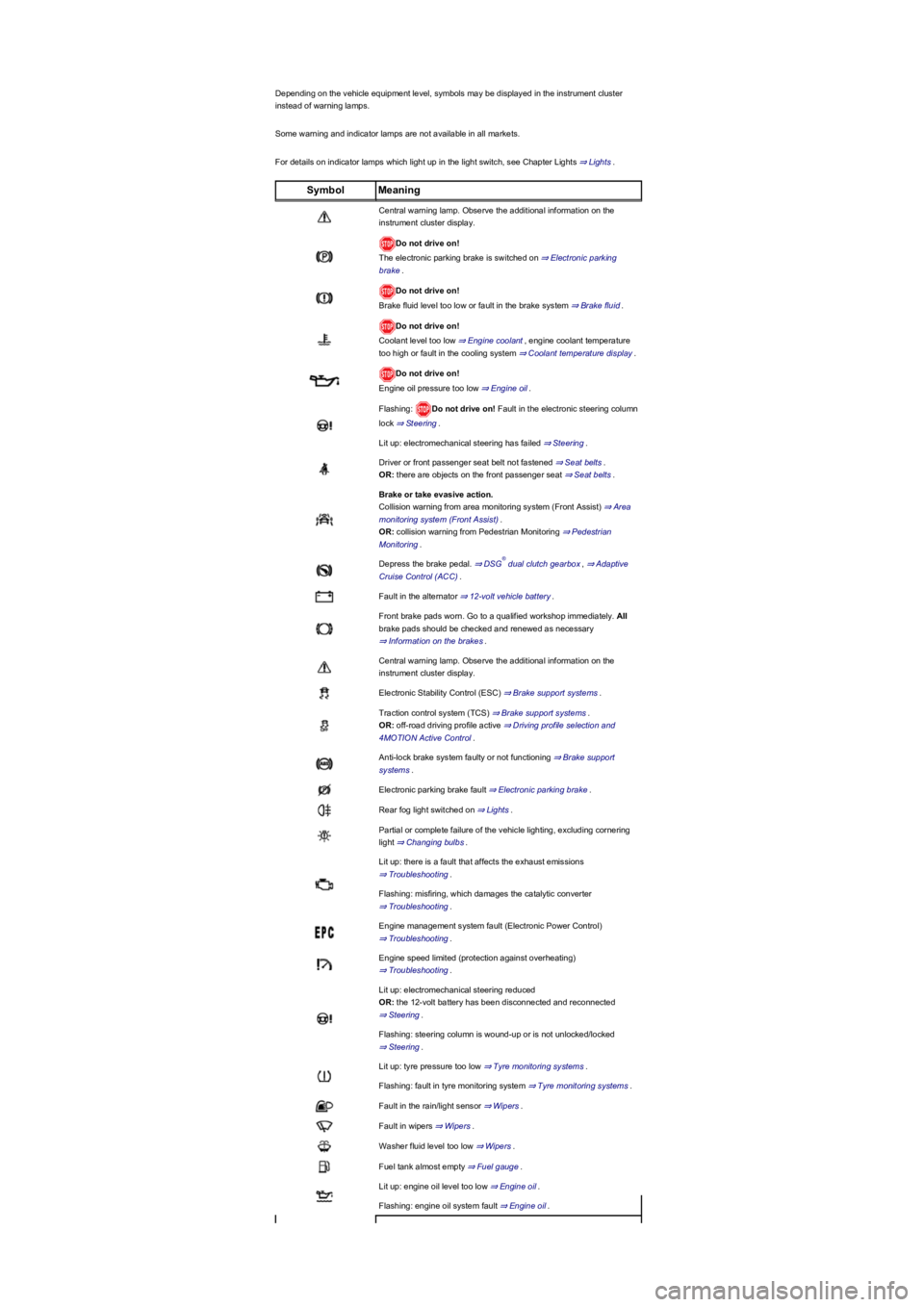
Depending on the vehicle equipment level, symbols may be displayed in the instrument cluster
instead of warning lamps.
Some warning and indicator lamps are not available in all markets.
For details on indicator lamps which light up in the light switch, see Chapter Lights в‡’В Lights.
SymbolMeaning
Central warning lamp. Observe the additional information on the
instrument cluster display.
Do not drive on!
The electronic parking brake is switched on в‡’В ElectronicВ parkingВ
brake.
Do not drive on!
Brake fluid level too low or fault in the brake system в‡’В BrakeВ fluid.
Do not drive on!
Coolant level too low в‡’В EngineВ coolant, engine coolant temperature
too high or fault in the cooling system в‡’В CoolantВ temperatureВ display.
Do not drive on!
Engine oil pressure too low в‡’В EngineВ oil.
Flashing: Do not drive on! Fault in the electronic steering column
lock в‡’В Steering.
Lit up: electromechanical steering has failed в‡’В Steering.
Driver or front passenger seat belt not fastened в‡’В SeatВ belts.
OR: there are objects on the front passenger seat в‡’В SeatВ belts.
Brake or take evasive action.
Collision warning from area monitoring system (Front Assist) в‡’В AreaВ
monitoringВ systemВ (FrontВ Assist).
OR: collision warning from Pedestrian Monitoring в‡’В PedestrianВ
Monitoring.
Depress the brake pedal. в‡’В DSGВ dualВ clutchВ gearbox, в‡’В AdaptiveВ
CruiseВ ControlВ (ACC).
Fault in the alternator в‡’В 12-voltВ vehicleВ battery.
Front brake pads worn. Go to a qualified workshop immediately. All
brake pads should be checked and renewed as necessary
в‡’В InformationВ onВ theВ brakes.
Central warning lamp. Observe the additional information on the
instrument cluster display.
Electronic Stability Control (ESC) в‡’В BrakeВ supportВ systems.
Traction control system (TCS) в‡’В BrakeВ supportВ systems.
OR: off-road driving profile active в‡’В DrivingВ profileВ selectionВ andВ
4MOTIONВ ActiveВ Control.
Anti-lock brake system faulty or not functioning в‡’В BrakeВ supportВ
systems.
Electronic parking brake fault в‡’В ElectronicВ parkingВ brake.
Rear fog light switched on в‡’В Lights.
Partial or complete failure of the vehicle lighting, excluding cornering
light в‡’В ChangingВ bulbs.
Lit up: there is a fault that affects the exhaust emissions
в‡’В Troubleshooting.
Flashing: misfiring, which damages the catalytic converter
в‡’В Troubleshooting.
Engine management system fault (Electronic Power Control)
в‡’В Troubleshooting.
Engine speed limited (protection against overheating)
в‡’В Troubleshooting.
Lit up: electromechanical steering reduced
OR: the 12-volt battery has been disconnected and reconnected
в‡’В Steering.
Flashing: steering column is wound-up or is not unlocked/locked
в‡’В Steering.
Lit up: tyre pressure too low в‡’В TyreВ monitoringВ systems.
Flashing: fault in tyre monitoring system в‡’В TyreВ monitoringВ systems.
Fault in the rain/light sensor в‡’В Wipers.
Fault in wipers в‡’В Wipers.
Washer fluid level too low в‡’В Wipers.
Fuel tank almost empty в‡’В FuelВ gauge.
Lit up: engine oil level too low в‡’В EngineВ oil.
Flashing: engine oil system fault в‡’В EngineВ oil.
В®
Page 11 of 341
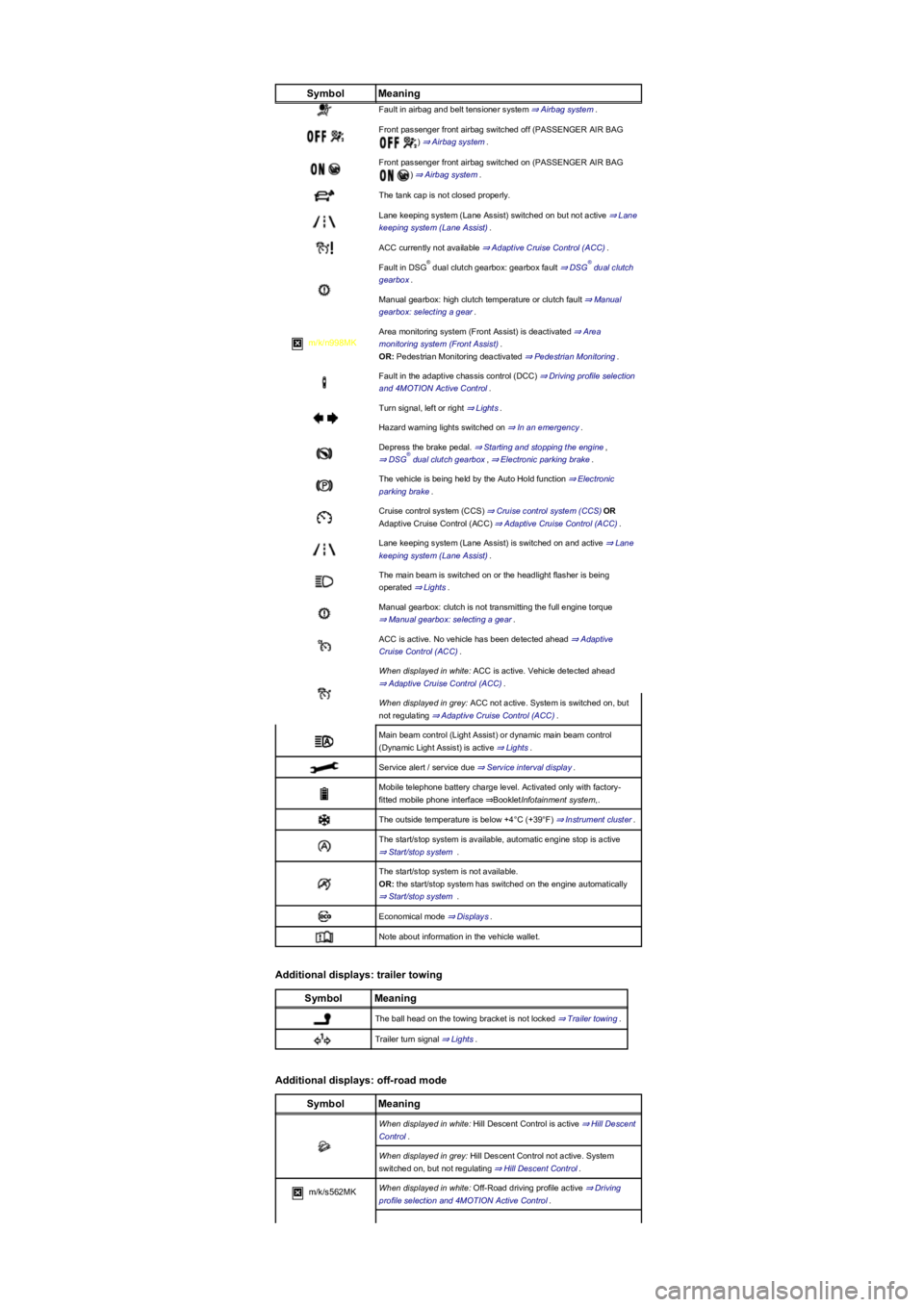
SymbolMeaning
Fault in airbag and belt tensioner system в‡’В AirbagВ system.
Front passenger front airbag switched off (PASSENGER AIR BAG
) в‡’В AirbagВ system.
Front passenger front airbag switched on (PASSENGER AIR BAG
) в‡’В AirbagВ system.
The tank cap is not closed properly.
Lane keeping system (Lane Assist) switched on but not active в‡’В LaneВ
keepingВ systemВ (LaneВ Assist).
ACC currently not available в‡’В AdaptiveВ CruiseВ ControlВ (ACC).
Fault in DSG dual clutch gearbox: gearbox fault в‡’В DSGВ dualВ clutchВ
gearbox.
Manual gearbox: high clutch temperature or clutch fault в‡’В ManualВ
gearbox:В selectingВ aВ gear.
m/k/n998MK
Area monitoring system (Front Assist) is deactivated в‡’В AreaВ
monitoringВ systemВ (FrontВ Assist).
OR: Pedestrian Monitoring deactivated в‡’В PedestrianВ Monitoring.
Fault in the adaptive chassis control (DCC) в‡’В DrivingВ profileВ selectionВ
andВ 4MOTIONВ ActiveВ Control.
Turn signal, left or right в‡’В Lights.
Hazard warning lights switched on в‡’В InВ anВ emergency.
Depress the brake pedal. в‡’В StartingВ andВ stoppingВ theВ engine,
в‡’В DSGВ dualВ clutchВ gearbox, в‡’В ElectronicВ parkingВ brake.
The vehicle is being held by the Auto Hold function в‡’В ElectronicВ
parkingВ brake.
Cruise control system (CCS) в‡’В CruiseВ controlВ systemВ (CCS)OR
Adaptive Cruise Control (ACC) в‡’В AdaptiveВ CruiseВ ControlВ (ACC).
Lane keeping system (Lane Assist) is switched on and active в‡’В LaneВ
keepingВ systemВ (LaneВ Assist).
The main beam is switched on or the headlight flasher is being
operated в‡’В Lights.
Manual gearbox: clutch is not transmitting the full engine torque
в‡’В ManualВ gearbox:В selectingВ aВ gear.
ACC is active. No vehicle has been detected ahead в‡’В AdaptiveВ
CruiseВ ControlВ (ACC).
WhenВ displayedВ inВ white: ACC is active. Vehicle detected ahead
в‡’В AdaptiveВ CruiseВ ControlВ (ACC).
WhenВ displayedВ inВ grey: ACC not active. System is switched on, but
not regulating в‡’В AdaptiveВ CruiseВ ControlВ (ACC).
Main beam control (Light Assist) or dynamic main beam control
(Dynamic Light Assist) is active в‡’В Lights.
Service alert / service due в‡’В ServiceВ intervalВ display.
Mobile telephone battery charge level. Activated only with factory-
fitted mobile phone interface в‡’BookletInfotainmentВ system,.
The outside temperature is below +4В°C (+39В°F) в‡’В InstrumentВ cluster.
The start/stop system is available, automatic engine stop is active
в‡’В Start/stopВ systemВ .
The start/stop system is not available.
OR: the start/stop system has switched on the engine automatically
в‡’В Start/stopВ systemВ .
Economical mode в‡’В Displays.
Note about information in the vehicle wallet.
Additional displays: trailer towing
SymbolMeaning
The ball head on the towing bracket is not locked в‡’В TrailerВ towing.
Trailer turn signal в‡’В Lights.
Additional displays: off-road mode
SymbolMeaning
WhenВ displayedВ inВ white: Hill Descent Control is active в‡’В HillВ DescentВ
Control.
WhenВ displayedВ inВ grey: Hill Descent Control not active. System
switched on, but not regulating в‡’В HillВ DescentВ Control.
m/k/s562MKWhenВ displayedВ inВ white: Off-Road driving profile active в‡’В DrivingВ
profileВ selectionВ andВ 4MOTIONВ ActiveВ Control.
®®
В®
Page 23 of 341
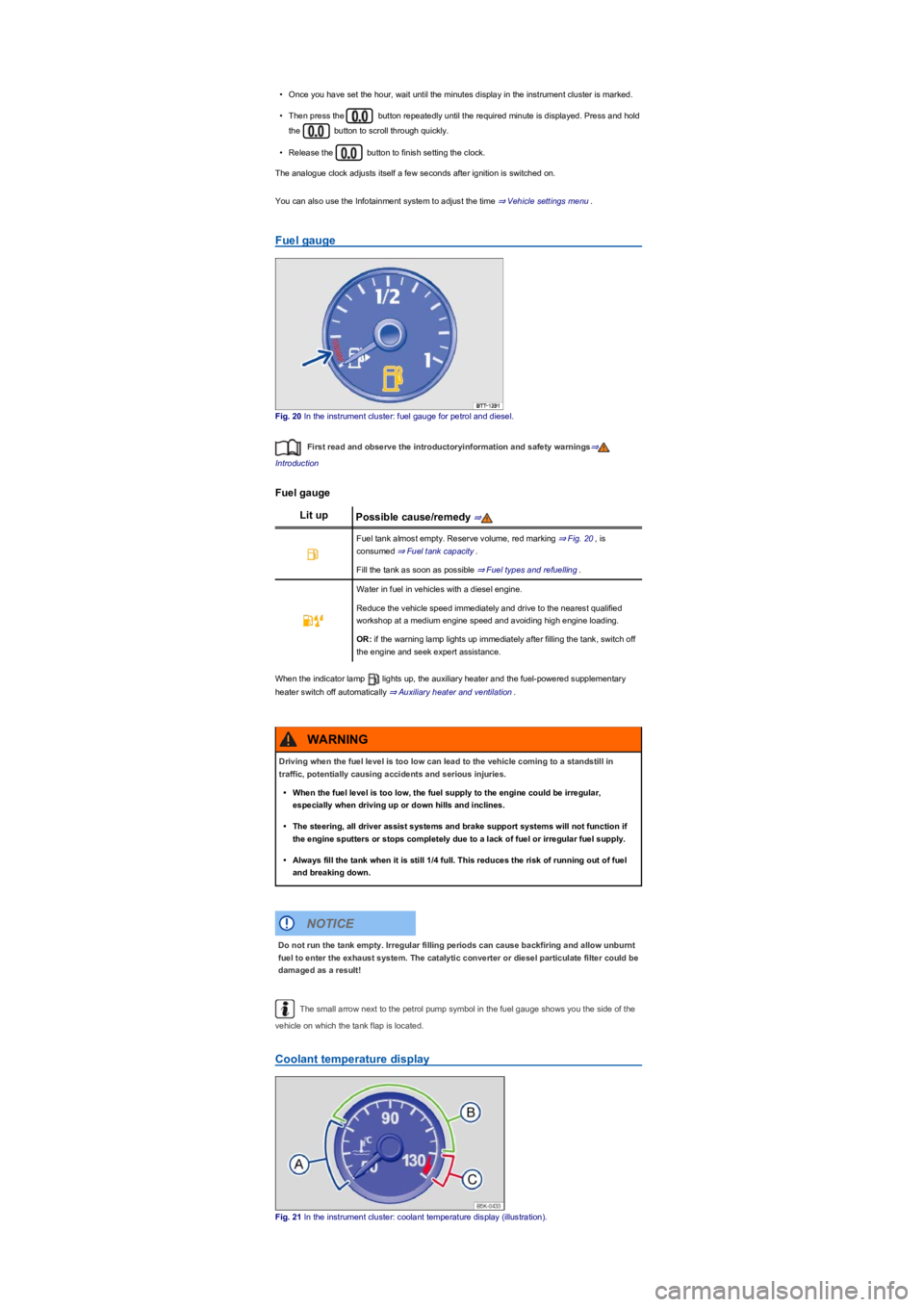
•Once you have set the hour, wait until the minutes display in the instrument cluster is marked.
•Then press the button repeatedly until the required minute is displayed. Press and hold
the button to scroll through quickly.
•Release the button to finish setting the clock.
The analogue clock adjusts itself a few seconds after ignition is switched on.
You can also use the Infotainment system to adjust the time в‡’В VehicleВ settingsВ menu.
Fuel gauge
Fig. 20 In the instrument cluster: fuel gauge for petrol and diesel.
First read and observe the introductoryinformation and safety warnings⇒
Introduction
Fuel gauge
Lit upPossible cause/remedy в‡’
Fuel tank almost empty. Reserve volume, red marking в‡’В Fig.В 20, is
consumed в‡’В FuelВ tankВ capacity.
Fill the tank as soon as possible в‡’В FuelВ typesВ andВ refuelling.
Water in fuel in vehicles with a diesel engine.
Reduce the vehicle speed immediately and drive to the nearest qualified
workshop at a medium engine speed and avoiding high engine loading.
OR: if the warning lamp lights up immediately after filling the tank, switch off
the engine and seek expert assistance.
When the indicator lamp lights up, the auxiliary heater and the fuel-powered supplementary
heater switch off automatically в‡’В AuxiliaryВ heaterВ andВ ventilation.
The small arrow next to the petrol pump symbol in the fuel gauge shows you the side of the
vehicle on which the tank flap is located.
Coolant temperature display
Fig. 21 In the instrument cluster: coolant temperature display (illustration).
Driving when the fuel level is too low can lead to the vehicle coming to a standstill in
traffic, potentially causing accidents and serious injuries.
•When the fuel level is too low, the fuel supply to the engine could be irregular,
especially when driving up or down hills and inclines.
•The steering, all driver assist systems and brake support systems will not function if
the engine sputters or stops completely due to a lack of fuel or irregular fuel supply.
•Always fill the tank when it is still 1/4 full. This reduces the risk of running out of fuel
and breaking down.
WARNING
Do not run the tank empty. Irregular filling periods can cause backfiring and allow unburnt
fuel to enter the exhaust system. The catalytic converter or diesel particulate filter could be
damaged as a result!
NOTICE
Page 29 of 341
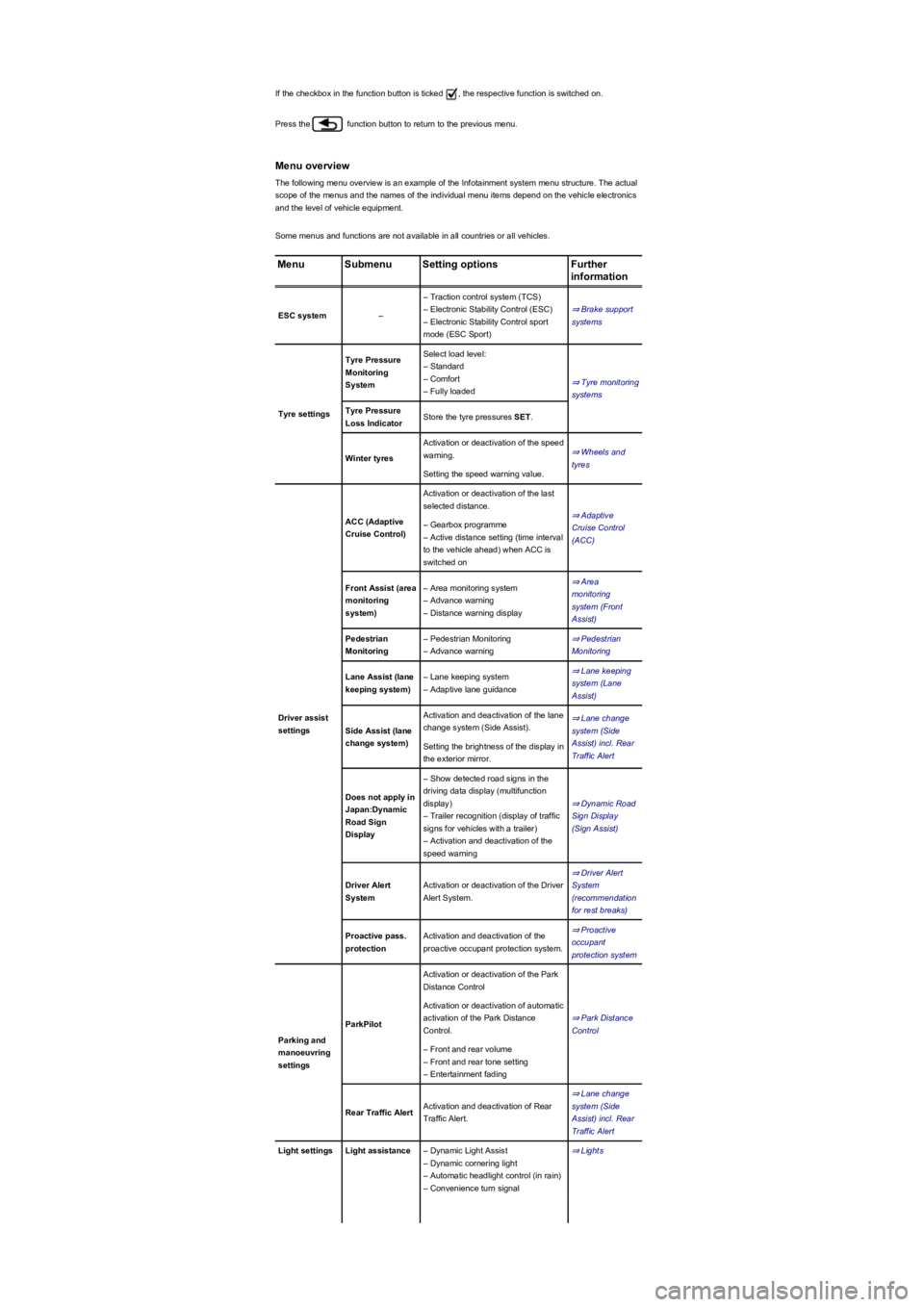
If the checkbox in the function button is ticked , the respective function is switched on.
Press the function button to return to the previous menu.
Menu overview
The following menu overview is an example of the Infotainment system menu structure. The actual
scope of the menus and the names of the individual menu items depend on the vehicle electronics
and the level of vehicle equipment.
Some menus and functions are not available in all countries or all vehicles.
MenuSubmenuSetting optionsFurther
information
ESC system–
– Traction control system (TCS)
– Electronic Stability Control (ESC)
– Electronic Stability Control sport
mode (ESC Sport)
в‡’В BrakeВ supportВ
systems
Tyre settings
Tyre Pressure
Monitoring
System
Select load level:
– Standard
– Comfort
– Fully loaded
в‡’В TyreВ monitoringВ
systems
Tyre Pressure
Loss IndicatorStore the tyre pressures SET.
Winter tyres
Activation or deactivation of the speed
warning.в‡’В WheelsВ andВ
tyres
Setting the speed warning value.
Driver assist
settings
ACC (Adaptive
Cruise Control)
Activation or deactivation of the last
selected distance.
в‡’В AdaptiveВ
CruiseВ ControlВ
(ACC)
– Gearbox programme
– Active distance setting (time interval
to the vehicle ahead) when ACC is
switched on
Front Assist (area
monitoring
system)
– Area monitoring system
– Advance warning
– Distance warning display
в‡’В AreaВ
monitoringВ
systemВ (FrontВ
Assist)
Pedestrian
Monitoring
– Pedestrian Monitoring
– Advance warning
в‡’В PedestrianВ
Monitoring
Lane Assist (lane
keeping system)
– Lane keeping system
– Adaptive lane guidance
в‡’В LaneВ keepingВ
systemВ (LaneВ
Assist)
Side Assist (lane
change system)
Activation and deactivation of the lane
change system (Side Assist).
в‡’В LaneВ changeВ
systemВ (SideВ
Assist)В incl.В RearВ
TrafficВ Alert
Setting the brightness of the display in
the exterior mirror.
Does not apply in
Japan:Dynamic
Road Sign
Display
– Show detected road signs in the
driving data display (multifunction
display)
– Trailer recognition (display of traffic
signs for vehicles with a trailer)
– Activation and deactivation of the
speed warning
в‡’В DynamicВ RoadВ
SignВ DisplayВ
(SignВ Assist)
Driver Alert
System
Activation or deactivation of the Driver
Alert System.
в‡’В DriverВ AlertВ
SystemВ
(recommendationВ
forВ restВ breaks)
Proactive pass.
protection
Activation and deactivation of the
proactive occupant protection system.
в‡’В ProactiveВ
occupantВ
protectionВ system
Parking and
manoeuvring
settings
ParkPilot
Activation or deactivation of the Park
Distance Control
в‡’В ParkВ DistanceВ
Control
Activation or deactivation of automatic
activation of the Park Distance
Control.
– Front and rear volume
– Front and rear tone setting
– Entertainment fading
Rear Traffic AlertActivation and deactivation of Rear
Traffic Alert.
в‡’В LaneВ changeВ
systemВ (SideВ
Assist)В incl.В RearВ
TrafficВ Alert
Light settingsLight assistance– Dynamic Light Assist
– Dynamic cornering light
– Automatic headlight control (in rain)
– Convenience turn signal
в‡’В Lights
Page 31 of 341
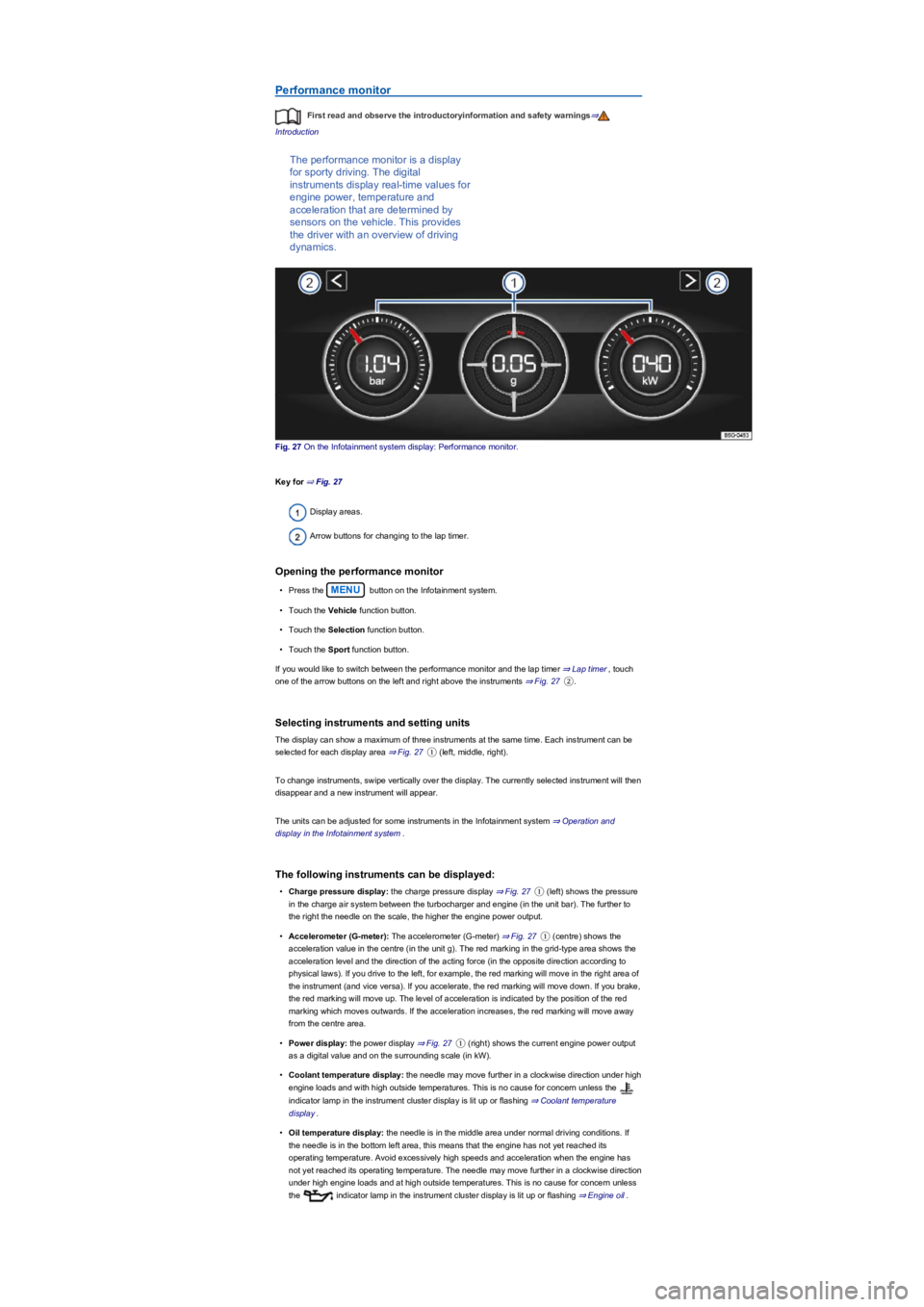
Performance monitor
First read and observe the introductoryinformation and safety warnings⇒
Introduction
The performance monitor is a display
for sporty driving. The digital
instruments display real-time values for
engine power, temperature and
acceleration that are determined by
sensors on the vehicle. This provides
the driver with an overview of driving
dynamics.
Fig. 27 On the Infotainment system display: Performance monitor.
Key for в‡’В Fig.В 27
Display areas.
Arrow buttons for changing to the lap timer.
Opening the performance monitor
•Press the MENU button on the Infotainment system.
•Touch the Vehicle function button.
•Touch the Selection function button.
•Touch the Sport function button.
If you would like to switch between the performance monitor and the lap timer в‡’В LapВ timer, touch
one of the arrow buttons on the left and right above the instruments в‡’В Fig.В 27в‘Ў.
Selecting instruments and setting units
The display can show a maximum of three instruments at the same time. Each instrument can be
selected for each display area в‡’В Fig.В 27в‘ (left, middle, right).
To change instruments, swipe vertically over the display. The currently selected instrument will then
disappear and a new instrument will appear.
The units can be adjusted for some instruments in the Infotainment system в‡’В OperationВ andВ
displayВ inВ theВ InfotainmentВ system.
The following instruments can be displayed:
•Charge pressure display: the charge pressure display ⇒ Fig. 27①(left) shows the pressure
in the charge air system between the turbocharger and engine (in the unit bar). The further to
the right the needle on the scale, the higher the engine power output.
•Accelerometer (G-meter): The accelerometer (G-meter) ⇒ Fig. 27①(centre) shows the
acceleration value in the centre (in the unit g). The red marking in the grid-type area shows the
acceleration level and the direction of the acting force (in the opposite direction according to
physical laws). If you drive to the left, for example, the red marking will move in the right area of
the instrument (and vice versa). If you accelerate, the red marking will move down. If you brake,
the red marking will move up. The level of acceleration is indicated by the position of the red
marking which moves outwards. If the acceleration increases, the red marking will move away
from the centre area.
•Power display: the power display ⇒ Fig. 27①(right) shows the current engine power output
as a digital value and on the surrounding scale (in kW).
•Coolant temperature display: the needle may move further in a clockwise direction under high
engine loads and with high outside temperatures. This is no cause for concern unless the
indicator lamp in the instrument cluster display is lit up or flashing в‡’В CoolantВ temperatureВ
display.
•Oil temperature display: the needle is in the middle area under normal driving conditions. If
the needle is in the bottom left area, this means that the engine has not yet reached its
operating temperature. Avoid excessively high speeds and acceleration when the engine has
not yet reached its operating temperature. The needle may move further in a clockwise direction
under high engine loads and at high outside temperatures. This is no cause for concern unless
the indicator lamp in the instrument cluster display is lit up or flashing в‡’В EngineВ oil.
Page 36 of 341
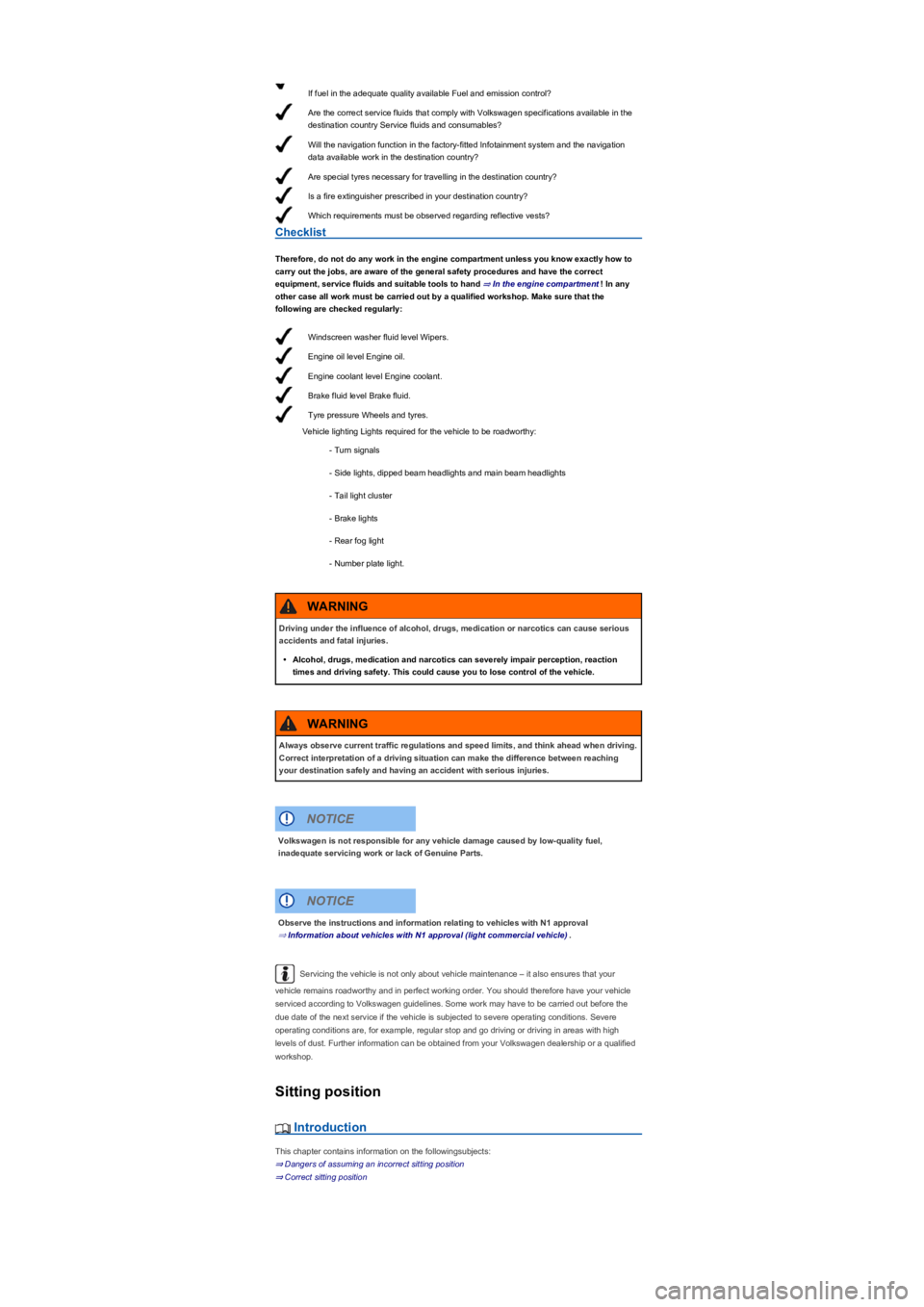
If fuel in the adequate quality available Fuel and emission control?
Are the correct service fluids that comply with Volkswagen specifications available in the
destination country Service fluids and consumables?
Will the navigation function in the factory-fitted Infotainment system and the navigation
data available work in the destination country?
Are special tyres necessary for travelling in the destination country?
Is a fire extinguisher prescribed in your destination country?
Which requirements must be observed regarding reflective vests?
Windscreen washer fluid level Wipers.
Engine oil level Engine oil.
Engine coolant level Engine coolant.
Brake fluid level Brake fluid.
Tyre pressure Wheels and tyres.
Checklist
Therefore, do not do any work in the engine compartment unless you know exactly how to
carry out the jobs, are aware of the general safety procedures and have the correct
equipment, service fluids and suitable tools to hand в‡’В InВ theВ engineВ compartment! In any
other case all work must be carried out by a qualified workshop. Make sure that the
following are checked regularly:
Vehicle lighting Lights required for the vehicle to be roadworthy:
- Turn signals
- Side lights, dipped beam headlights and main beam headlights
- Tail light cluster
- Brake lights
- Rear fog light
- Number plate light.
Servicing the vehicle is not only about vehicle maintenance – it also ensures that your
vehicle remains roadworthy and in perfect working order. You should therefore have your vehicle
serviced according to Volkswagen guidelines. Some work may have to be carried out before the
due date of the next service if the vehicle is subjected to severe operating conditions. Severe
operating conditions are, for example, regular stop and go driving or driving in areas with high
levels of dust. Further information can be obtained from your Volkswagen dealership or a qualified
workshop.
Sitting position
Introduction
This chapter contains information on the followingsubjects:
в‡’В DangersВ ofВ assumingВ anВ incorrectВ sittingВ position
в‡’В CorrectВ sittingВ position
Driving under the influence of alcohol, drugs, medication or narcotics can cause serious
accidents and fatal injuries.
•Alcohol, drugs, medication and narcotics can severely impair perception, reaction
times and driving safety. This could cause you to lose control of the vehicle.
WARNING
Always observe current traffic regulations and speed limits, and think ahead when driving.
Correct interpretation of a driving situation can make the difference between reaching
your destination safely and having an accident with serious injuries.
WARNING
Volkswagen is not responsible for any vehicle damage caused by low-quality fuel,
inadequate servicing work or lack of Genuine Parts.
NOTICE
Observe the instructions and information relating to vehicles with N1 approval
в‡’В InformationВ aboutВ vehiclesВ withВ N1В approvalВ (lightВ commercialВ vehicle).
NOTICE
Page 46 of 341
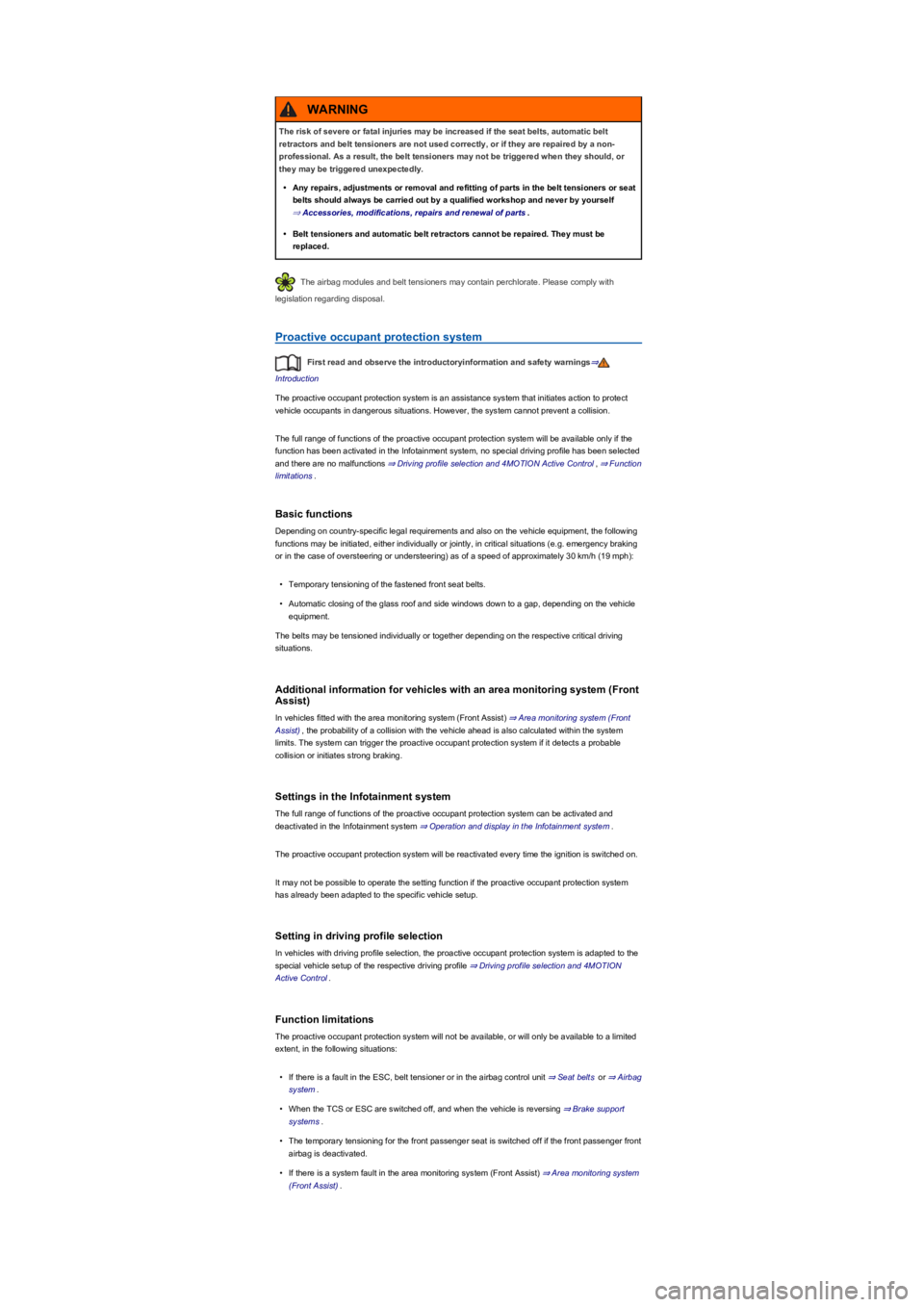
The airbag modules and belt tensioners may contain perchlorate. Please comply with
legislation regarding disposal.
Proactive occupant protection system
First read and observe the introductoryinformation and safety warnings⇒
Introduction
The proactive occupant protection system is an assistance system that initiates action to protect
vehicle occupants in dangerous situations. However, the system cannot prevent a collision.
The full range of functions of the proactive occupant protection system will be available only if the
function has been activated in the Infotainment system, no special driving profile has been selected
and there are no malfunctions в‡’В DrivingВ profileВ selectionВ andВ 4MOTIONВ ActiveВ Control, в‡’В FunctionВ
limitations.
Basic functions
Depending on country-specific legal requirements and also on the vehicle equipment, the following
functions may be initiated, either individually or jointly, in critical situations (e.g. emergency braking
or in the case of oversteering or understeering) as of a speed of approximately 30 km/h (19 mph):
•Temporary tensioning of the fastened front seat belts.
•Automatic closing of the glass roof and side windows down to a gap, depending on the vehicle
equipment.
The belts may be tensioned individually or together depending on the respective critical driving
situations.
Additional information for vehicles with an area monitoring system (Front
Assist)
In vehicles fitted with the area monitoring system (Front Assist) в‡’В AreaВ monitoringВ systemВ (FrontВ
Assist), the probability of a collision with the vehicle ahead is also calculated within the system
limits. The system can trigger the proactive occupant protection system if it detects a probable
collision or initiates strong braking.
Settings in the Infotainment system
The full range of functions of the proactive occupant protection system can be activated and
deactivated in the Infotainment system в‡’В OperationВ andВ displayВ inВ theВ InfotainmentВ system.
The proactive occupant protection system will be reactivated every time the ignition is switched on.
It may not be possible to operate the setting function if the proactive occupant protection system
has already been adapted to the specific vehicle setup.
Setting in driving profile selection
In vehicles with driving profile selection, the proactive occupant protection system is adapted to the
special vehicle setup of the respective driving profile в‡’В DrivingВ profileВ selectionВ andВ 4MOTIONВ
ActiveВ Control.
Function limitations
The proactive occupant protection system will not be available, or will only be available to a limited
extent, in the following situations:
•If there is a fault in the ESC, belt tensioner or in the airbag control unit в‡’В SeatВ belts or в‡’В AirbagВ
system.
•When the TCS or ESC are switched off, and when the vehicle is reversing в‡’В BrakeВ supportВ
systems.
•The temporary tensioning for the front passenger seat is switched off if the front passenger front
airbag is deactivated.
•If there is a system fault in the area monitoring system (Front Assist) в‡’В AreaВ monitoringВ systemВ
(FrontВ Assist).
The risk of severe or fatal injuries may be increased if the seat belts, automatic belt
retractors and belt tensioners are not used correctly, or if they are repaired by a non-
professional. As a result, the belt tensioners may not be triggered when they should, or
they may be triggered unexpectedly.
•Any repairs, adjustments or removal and refitting of parts in the belt tensioners or seat
belts should always be carried out by a qualified workshop and never by yourself
в‡’В Accessories,В modifications,В repairsВ andВ renewalВ ofВ parts.
•Belt tensioners and automatic belt retractors cannot be repaired. They must be
replaced.
WARNING
Page 62 of 341
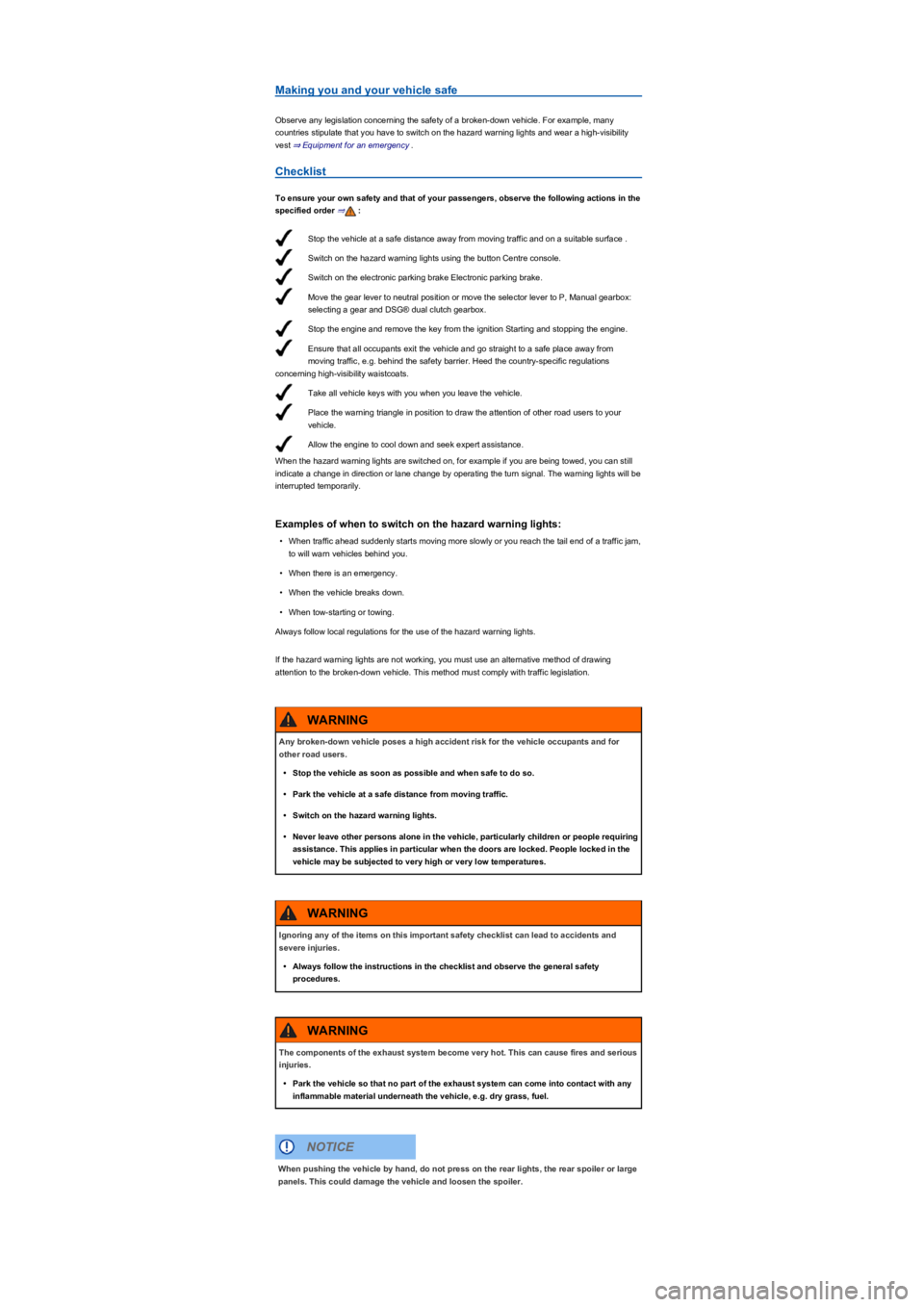
Stop the vehicle at a safe distance away from moving traffic and on a suitable surface .
Switch on the hazard warning lights using the button Centre console.
Switch on the electronic parking brake Electronic parking brake.
Move the gear lever to neutral position or move the selector lever to P, Manual gearbox:
selecting a gear and DSGВ® dual clutch gearbox.
Stop the engine and remove the key from the ignition Starting and stopping the engine.
Ensure that all occupants exit the vehicle and go straight to a safe place away from
moving traffic, e.g. behind the safety barrier. Heed the country-specific regulations
concerning high-visibility waistcoats.
Take all vehicle keys with you when you leave the vehicle.
Place the warning triangle in position to draw the attention of other road users to your
vehicle.
Allow the engine to cool down and seek expert assistance.
Making you and your vehicle safe
Observe any legislation concerning the safety of a broken-down vehicle. For example, many
countries stipulate that you have to switch on the hazard warning lights and wear a high-visibility
vest в‡’В EquipmentВ forВ anВ emergency.
Checklist
To ensure your own safety and that of your passengers, observe the following actions in the
specified order в‡’:
When the hazard warning lights are switched on, for example if you are being towed, you can still
indicate a change in direction or lane change by operating the turn signal. The warning lights will be
interrupted temporarily.
Examples of when to switch on the hazard warning lights:
•When traffic ahead suddenly starts moving more slowly or you reach the tail end of a traffic jam,
to will warn vehicles behind you.
•When there is an emergency.
•When the vehicle breaks down.
•When tow-starting or towing.
Always follow local regulations for the use of the hazard warning lights.
If the hazard warning lights are not working, you must use an alternative method of drawing
attention to the broken-down vehicle. This method must comply with traffic legislation.
Any broken-down vehicle poses a high accident risk for the vehicle occupants and for
other road users.
•Stop the vehicle as soon as possible and when safe to do so.
•Park the vehicle at a safe distance from moving traffic.
•Switch on the hazard warning lights.
•Never leave other persons alone in the vehicle, particularly children or people requiring
assistance. This applies in particular when the doors are locked. People locked in the
vehicle may be subjected to very high or very low temperatures.
WARNING
Ignoring any of the items on this important safety checklist can lead to accidents and
severe injuries.
•Always follow the instructions in the checklist and observe the general safety
procedures.
WARNING
The components of the exhaust system become very hot. This can cause fires and serious
injuries.
•Park the vehicle so that no part of the exhaust system can come into contact with any
inflammable material underneath the vehicle, e.g. dry grass, fuel.
WARNING
When pushing the vehicle by hand, do not press on the rear lights, the rear spoiler or large
panels. This could damage the vehicle and loosen the spoiler.
NOTICE